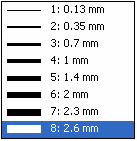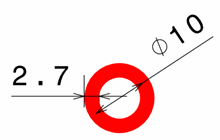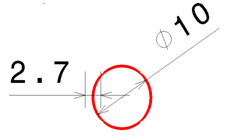Note that the V5 PostScript interpreter is only able to load PostScript files generated by V5. Therefore, PostScript files exported from other softwares (such as Adobe Illustrator) cannot be loaded in V5.
Vector
The following vector graphics formats are supported by the Open command and some specific import functionality (such as Tools > Import From File...):
- Windows Metafile (Windows only)
- CGM
The following CGM vector formats are supported:- CGM
- CGM CALS
- CGM ATA
- CGM Graphic Software.
CGM (Computer Graphics Metafile) is an ANSI/ISO standardized platform-independent format used for the interchange of vector and bitmap data.
Version 5 supports the CGM Version 1 and Version 3 standards. CGM Version 3 adds vector primitives such as Bezier and Nurbs, improved font and text support as well as bitmap compression.
The CGM-ATA and CGM-CALS profiles which are specific subsets of the Version 3 standard are also supported.
For detailed information about CGM formats, browse the following Internet site:http://www.cgmopen.org. - PS (PostScript)
PostScript is a page description language that supports text, vector graphics and bitmaps. It is device-independent and implements an industry standard for communicating graphic information between applications and hardware devices such as printers.
For detailed information about PostScript, browse the following Internet site:http://partners.adobe.com/asn/developer/pdfs/tn/PLRM.pdf. - PDF: Portable Document Format is a platform-independent page
description file format designed for platform exchange. It may
contain text, vector graphics and bitmaps.
For detailed information about PDF, browse the following Internet site:http://partners.adobe.com/asn/pdfl/PDFS/PDFLibraryFAQ.pdf. - HPGL/HPGL2 (Hewlett-Packard Graphics Language)
This file format is an instruction set developped for controlling plotters. HP-GL, which as been developped for pen plotters, is now obsolete. HP-GL/2-RTL is an evolution of HP-GL providing more graphic primitives (such as polygons or curves) and a support for bitmaps. - SVG (Scalable Vector Graphics)
This format is an XML (Extensible Markup Language) grammar for 2D graphics.
The advantage of vector files over bitmap files is that image scaling does not affect image appearance. When zooming bitmap files, pixels become visible as shown in the example below:
| Vector image | Bitmap image |
 |
 |
|
Purpose |
Printing/Plotting |
Data Exchange |
|---|---|---|
| Format | ||
| HPGL/2-RTL | Yes | No |
| PS | Yes | No |
| EPS | No | Yes |
| No | Yes | |
| CGM | No | Yes |
Raster
The following raster graphics formats are supported by the Open functionality and some other specific applicative import functions:
- Adobe Photoshop Format (*.psd)
- Apple Macintosh File Format (*.pic)
- Amiga IFF (*.iff)
- CALS Group 4 (*.cals)
- HP/RTL (UNIX only)
- JPEG Fair Quality (*.jpg)
- JPEG Medium Quality (*.jpg)
- JPEG High Quality (*.jpg)
- PNG (Portable Network Graphics) (*.png)
- Silicon Graphics File (*.rgb)
- Sun Raster File (*.ras)
- TIFF CCITT Group 4 (*.tif)
- TIFF True Color (*.tif)
- TIFF Indexed Packbit (*.tif)
- TIFF True Color Packbit (*.tif)
- TIFF Indexed (*.tif)
- TIFF Grey Scale Packbit (*.tif)
- TIFF BW Packbit (*.tif)
- Truevision Targa (*.tga)
- RGB (SGI Format) Not Compressed (*.rgb)
- ZSoft Paintbrush (*.pcx)
- Windows Bitmap (*.bmp)
- X-Window Pixmap (*.xpm)
- X-Window Dump (*.xwd).
For detailed information about JPG and TIFF format, browse the following Internet sites:
http://www.jpeg.org
and http://www.ijg.org
http://partners.adobe.com/asn/developer/pdfs/tn/TIFFphotoshop.pdf
| Format |
Bit depth |
Compression |
Max. size in pixels |
Comments |
||||||||
|---|---|---|---|---|---|---|---|---|---|---|---|---|
| 1 | 8 | 16 | 24 | 32 | None | RLE | JPEG | ZLIB | CCITT | |||
| BMP | X | X | X | X | X | X | X | 2G*2G | Standard bitmap storage on MS-Windows | |||
| JPEG | X | X | X | X | 64K*64K | Very few applications support the lossless JPEG mode | ||||||
| PNG | X | X | X | X | X | X | 2G*2G | Successor of the GIF format | ||||
| RGB | X | X | X | X | X | X | X | 64K*64K | Supported by very few applications | |||
| TIFF | X | X | X | X | X | X | X | X | 2G*2G | Very popular and general format recognized by most imaging applications | ||
Stroke Properties
You should be aware of the following behaviors regarding stroke properties:
Thickness
V5 defines line thickness indexes through a table (see Thickness & Font). Each thickness index has a mm and pixel definition. The thickness information stored in the document is a length (e.g. 2.5 mm).
When importing or opening a vector graphics document with a stroke of
"x" mm, a V5 stroke is created with a thickness index whose mm
definition is "x".
If no index has a mm equal to "x", then the index with the closest mm
definition is chosen.
You might enrich the standards to ensure a better match.
When displayed on screen in V5, the stroke thickness is independent of the zoom factor: it has a fixed thickness defined in pixels (the pixel definition of its thickness index).
As an example, let’s consider a SVG file with a 10 mm diameter radius and a 2.7 mm thickness:
- If you import this SVG in a CATDrawing, the V5 circle created has a thickness index 8 (2.6 mm is the closest thickness to 2.7 mm).
- However, when displayed on screen, the circle is 8 pixels thick, whatever the zoom level.
|
|
|
|
SVG file |
CATDrawing with imported SVG file |
 |
|
| Circle thickness properties in V5 |
Linejoin, Linecap
A vector graphics document might contains polylines with linejoin and linecap properties. However, the V5 stroke has no such properties. Therefore, when importing or opening in V5 a vector graphics format document containing a polyline with a linejoin or linecap property, the resulting polyline created in V5 is displayed without any consideration of this property:
| SVG linejoin properties | SVG linecap properties | |
 |
 |
 |
|
"Miter" join |
"Round" join |
"Round" cap |
| Polyline displayed in V5 | ||
 |
||
TTF font format
When printing text in TTF format with a negative spacing to a PS, PDF or any other 2D graphics format, whitish lines appear when opening the generated output in a non-V6 viewer.

